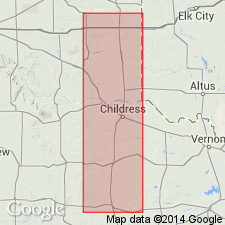
- Usage in publication:
-
- Dozier Mounds dolomite
- Dozier Mounds dolomite member
- Modifications:
-
- Original reference
- Dominant lithology:
-
- Dolomite
- AAPG geologic province:
-
- Palo Duro basin
Summary:
Pg. 422, 438, 439, 450-457. Referred to as Dozier Mounds dolomite and Dozier Mounds dolomite member of Custer formation. When Custer was originally defined (Roth, 1932), base of Dozier Mounds dolomite was chosen as base of Custer because Dozier Mounds dolomite [Roth did not use formal name Dozier Mounds in his 1932 report] and Verden channel dolomite of Oklahoma were considered the same. Present study shows that Dozier Mounds dolomite is not always at base of Custer. Interval between Dozier Mounds dolomite and base of Custer increases as section is traced southwestward from Collingsworth County. First description of unit credited to Gould (1906, USGS Water-Supply Paper 154), who described unit near middle of Quartermaster as ledge of rather hard red or pinkish more or less oolitic sandstone, which on weathering gives rise to a number of flat-topped buttes and ridges. One of most typical [buttes] is Dozier Mounds, near Dozier Post Office. [On plate 8, Gould showed a hill in Rocking Chair Mountains capped by Dozier sandstone.] Age is Triassic.
Type locality: in NE/4 NE/4 NE/4 sec. 28, Blk. 16, H. and G. N. Survey, Collingsworth Co., TX. Named from Dozier Mounds, TX.
Source: US geologic names lexicon (USGS Bull. 1200, p. 1154).
For more information, please contact Nancy Stamm, Geologic Names Committee Secretary.
Asterisk (*) indicates published by U.S. Geological Survey authors.
"No current usage" (†) implies that a name has been abandoned or has fallen into disuse. Former usage and, if known, replacement name given in parentheses ( ).
Slash (/) indicates name conflicts with nomenclatural guidelines (CSN, 1933; ACSN, 1961, 1970; NACSN, 1983, 2005, 2021). May be explained within brackets ([ ]).

